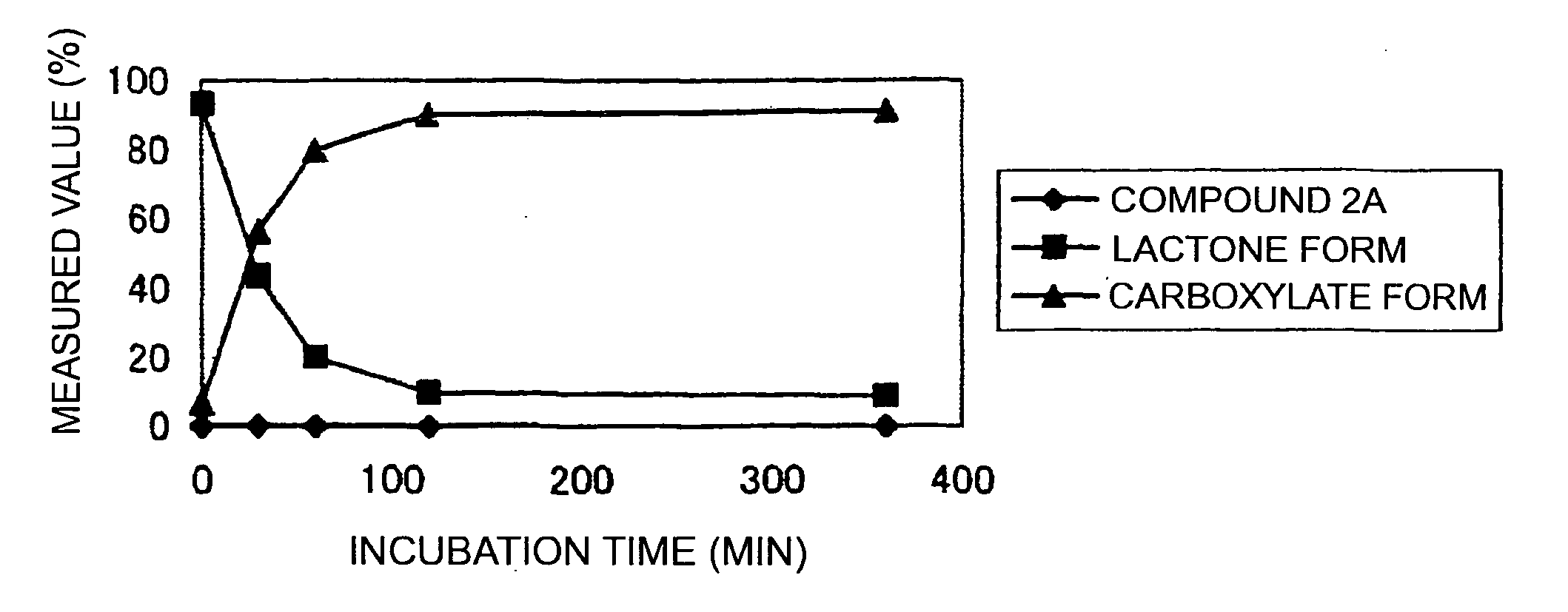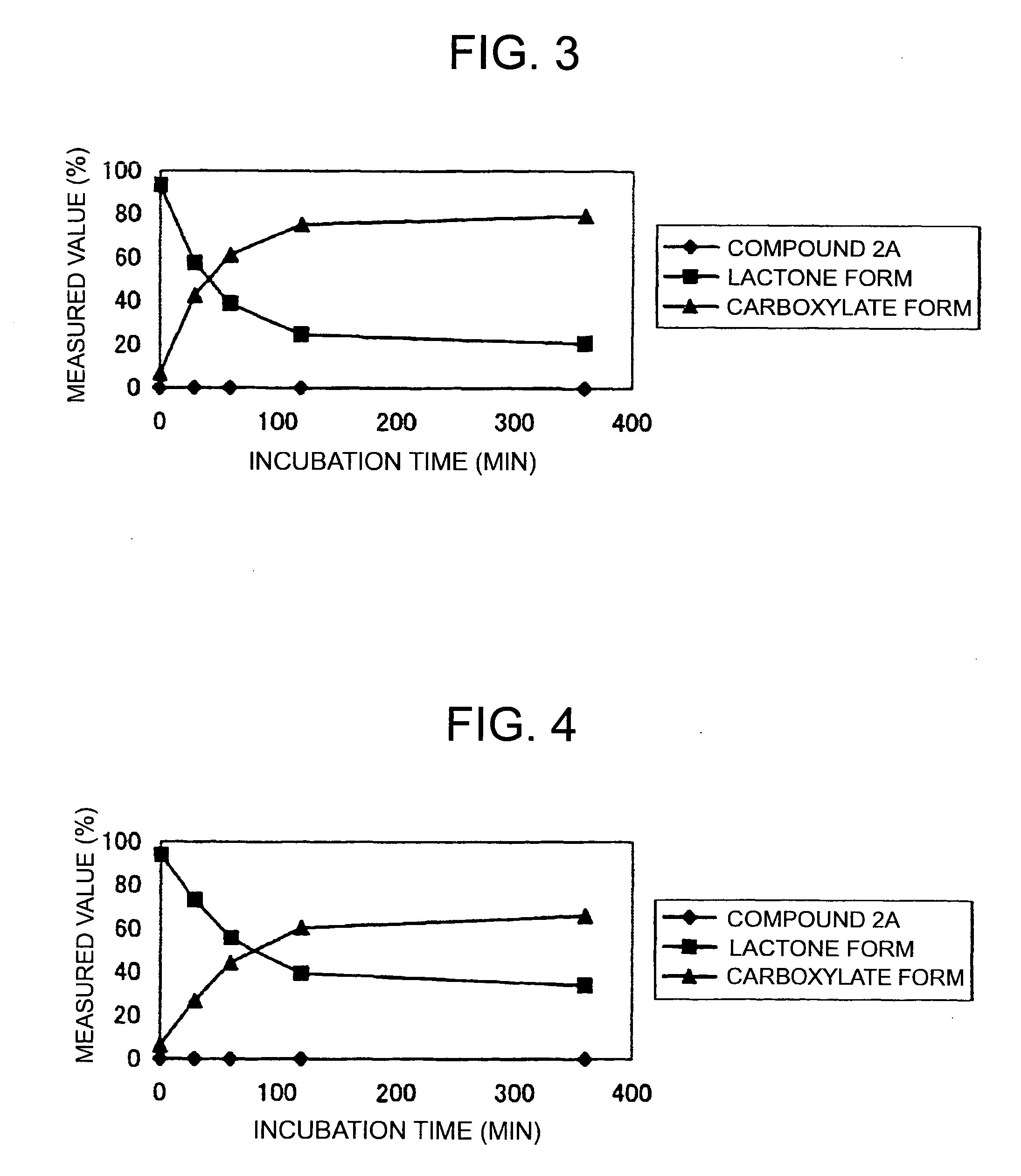Novel Water-Soluble Prodrugs
a water-soluble prodrug and water-soluble technology, applied in the direction of ester active ingredients, drug compositions, respiratory disorders, etc., can solve the problems of insufficient rate and efficiency in converting a prodrug to its active form in blood, and the need to shorten the time taken for the blood concentration of pharmaceutical agents to increase, so as to achieve good water solubility and stable
- Summary
- Abstract
- Description
- Claims
- Application Information
AI Technical Summary
Benefits of technology
Problems solved by technology
Method used
Image
Examples
example 1
(9S)-9-Ethyl-9-{[methyl-(2-methylamino-ethyl)-amino]-acetoxy}-1-pentyl-1H,12H-pyrano[3″,4″:6′,7′]indolizino[1′,2′:6,5pyrido[4,3,2-de]quinazoline-10,13(9H,15H)-dione hydrochloride
[0514]
Process 1-A
{[2-(tert-Butoxycarbonyl-methyl-amino)-ethyl]-methyl-amino}-acetic acid benzyl ester
[0515]
[0516] 854 mg (4.54 mmol) of methyl-(2-methyl-amino-ethyl)-carbamic acid tert-butyl ester, which is a known substance (J. Med. Chem., 2000, 43, 3093), was dissolved in methylene chloride (50 mL), and then benzyl 2-bromoacetate (1.0 mL, 6.35 mmol) was added to this solution, and the mixture was stirred at room temperature for approximately 24 hours.
[0517] After completion of the reaction, the reaction solution was concentrated, and the residue obtained was purified by silica gel column chromatography (hexane:ethyl acetate=5:1 to 3:1) to give 534.3 mg (35%) of {[2-(tert-butoxycarbonyl-methyl-amino)-ethyl]-methyl-amino}-acetic acid benzyl ester as a colorless viscous oil.
[0518]1H-NMR (270 MHz, CDCl3)...
example 2
(9S)-9-Ethyl-9-(glycyl-sarcosyloxy)-1-pentyl-1H,12H-pyrano[3″,4″:6′,7′]indolizino[1′,2′:6,5]pyrido[4,3,2-de]quinazoline-10,13(9H,15H)-dione hydrochloride (Compound 2A)
[0534]
Process 2-A
(9S)-9-{[N-(tert-Butoxycarbonyl)-glycyl]-sarcosyloxy}-9-ethyl-1-pentyl-1H,12H-pyrano[3″,4″: 6′,7′]indolizino[1′,2′:6,5]pyrido[4,3,2-de]quinazoline-10,13(9H,15H)-dione
[0535]
[0536] 1.4 g (5.67 mmol) of [N-(tert-butoxycarbonyl)-glycyl]-sarcosine, which is a known substance (Helvetica Chimica Acta, 1991, 74, 197), 1.3 g (2.84 mmol) of (9S)-9-ethyl-9-hydroxy-1-pentyl-1H,12H-pyrano[3″,4″:6′,7′]indolizino[1′,2′:6,5]pyrido[4,3,2-de]quinazoline-10,13(9H,15H)-dione, 2.2 g (11.34 mmol) of 1-ethyl-3-(3-dimethylaminopropyl)-carbodiimide hydrochloride, and 1.4 g (11.34 mmol) of 4-dimethylaminopyridine were dissolved in methylene chloride (50 mL), and then stirred at room temperature for 1.5 hours.
[0537] The reaction solution was washed with 0.2 N aqueous hydrochloric acid and saturated aqueous sodium hydrogen c...
example 3
(9S)-9-1[(2-Amino-ethyl)-methyl-amino]-acetoxy}-9-ethyl-1-pentyl-1H,12H-pyrano[3″,4″:6′,7′]indolizino[1′,2′:6,5]pyrido[4,3,2-de]quinazoline-10,13(9H,15H)-dione hydrochloride
[0551]
Process 3-A
{[2-(tert-Butoxycarbonylamino)-ethyl]-methyl-amino}-acetic acid benzyl ester
[0552]
[0553] 500 mg (1.42 mmol) of sarcosine benzyl ester p-toluenesulfonate, 478 mg (2.13 mmol) of 2-(tert-butoxycarbonylamino)-ethyl bromide, and 0.25 mL (2.13 mmol) of diisopropyl-ethylamine were dissolved in methylene chloride (10 mL), and then stirred at room temperature for approximately three days. After completion of the reaction, the reaction solution was concentrated and the residue obtained was purified by silica gel column chromatography (ethyl acetate) to yield 175 mg (38%) of {[2-(tert-butoxycarbonylamino)-ethyl]-methyl-amino}-acetic acid benzyl ester as a colorless viscous oil.
[0554]1H-NMR (270 MHz, CDCl3) δ(ppm): 1.44 (9H, s), 2.37 (3H, s), 2.63 (2H, t, J=6.0 Hz), 3.20 (2H, br.q), 3.33 (2H, s), 5.15 (...
PUM
| Property | Measurement | Unit |
|---|---|---|
| solubility | aaaaa | aaaaa |
| solubility | aaaaa | aaaaa |
| temperature | aaaaa | aaaaa |
Abstract
Description
Claims
Application Information
 Login to View More
Login to View More - R&D
- Intellectual Property
- Life Sciences
- Materials
- Tech Scout
- Unparalleled Data Quality
- Higher Quality Content
- 60% Fewer Hallucinations
Browse by: Latest US Patents, China's latest patents, Technical Efficacy Thesaurus, Application Domain, Technology Topic, Popular Technical Reports.
© 2025 PatSnap. All rights reserved.Legal|Privacy policy|Modern Slavery Act Transparency Statement|Sitemap|About US| Contact US: help@patsnap.com



